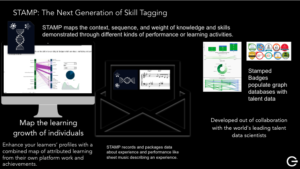Embracing the Diverse Taxonomies of Micro-Credentialing: Building Bridges for a Translatable Future
In the dynamic landscape of education and micro-credentialing, we find the interesting challenge of translating unique organizational cultures into structured data taxonomies… We realize that each organization actually has its own unique language.
Just as families and cultures develop distinct dialects, the same phenomenon is observed within various professional niches. We can even witness stark differences in vocabularies between generations, such as Gen Z and Boomers, so it makes sense that taxonomies should be as diverse and in a constant state of flux.
However, while the proliferation of taxonomies might seem overwhelming, the key lies not in striving for a unified “Master” taxonomy that everyone adopts, but its actually rather important to empower and courage diverse taxonomies, unique to each organization to be built.
However, this cannot occur in isolation. To foster effective communication and ensure meaningful connections, the education micro-credentialing Learning and Employment Record (LER) ecosystem requires industry registries and public taxonomies that serve as reference points, like a modern-day Rosetta Stone.
The Power of Diverse Taxonomies: In the micro-credentialing realm, the concept of building individual taxonomies is a natural progression. It allows individuals and organizations to express their unique perspectives, experiences, and competencies. Just as dialects reflect the nuances and richness of different cultures, diverse taxonomies capture the depth and complexity of specialized domains. When people build their taxonomies, they are creating a language that resonates with their context, promoting greater authenticity and relevance.
Avoiding Isolation: The Importance of Reference Points: While the individual creation of taxonomies is valuable, it is crucial to avoid isolation. The existence of industry registries and public taxonomies provides essential reference points that enable meaningful connections between different taxonomies. Just as a webpage’s language schema aids search engine indexing, the use of a “key signature” or reference note in credentialing helps establish a clear relationship between terms chosen and those in the public registry or taxonomy. This ensures efficient communication and avoids misunderstandings.
Navigating Skill Differentiation: In the context of skill differentiation, where terms can carry multiple meanings or interpretations, having a reference point becomes even more vital. Take, for instance, the skill category of “management.” Without additional context, it could refer to either a role or a specific skill set. By explicitly referencing a particular taxonomy like Onet’s role taxonomy, the intended meaning becomes clear. This clarity ensures that micro-credentials accurately capture the nuances and distinctions of skills, avoiding ambiguity or misinterpretation.
One existing framework that promotes clarity in skill tagging is the Credential Transparency Description Language (CTDL). By leveraging CTDL, stakeholders in the LER ecosystem can provide precise descriptions of their credentials, specifying the taxonomy or registry they reference. This transparent approach enhances the credibility and consistency of micro-credentials, enabling a more accurate representation of an individual’s achievements and competencies.
Looking ahead, as the field of micro-credentialing evolves, the need for future standards becomes evident. Open Badges 3 is a promising development that allows everyone to fill badges with richer data, ensuring greater granularity and context. This allows for additional languages like the Standardized Talent Asset Mapping Protocol (STAMP) to measure the relationships, scale, and context of skill tags within defined experiences, and power scaled data visualizations of skills. These advancements pave the way for a comprehensive and multidimensional representation of credentialed skills, allowing people to visualize skill context and not just read about skill verification.
So build your custom taxonomies! In the education micro-credentialing LER ecosystem, the diverse taxonomies we encounter are a testament to the richness and variety of experiences and expertise. Instead of seeking a unified taxonomy, it is crucial to embrace the multitude of languages that emerge from different contexts. By leveraging industry registries, public taxonomies, and reference points, we can bridge the gap between these taxonomies, fostering effective communication and meaningful connections. As we move forward, the adoption of standards such as CTDL, Open Badges 3, and STAMP will facilitate a future where micro-credentials provide a holistic and accurate representation of an individual’s skills and achievements. Together, let us build a translatable future that celebrates the diversity of taxonomies within the education micro-credentialing landscape.





